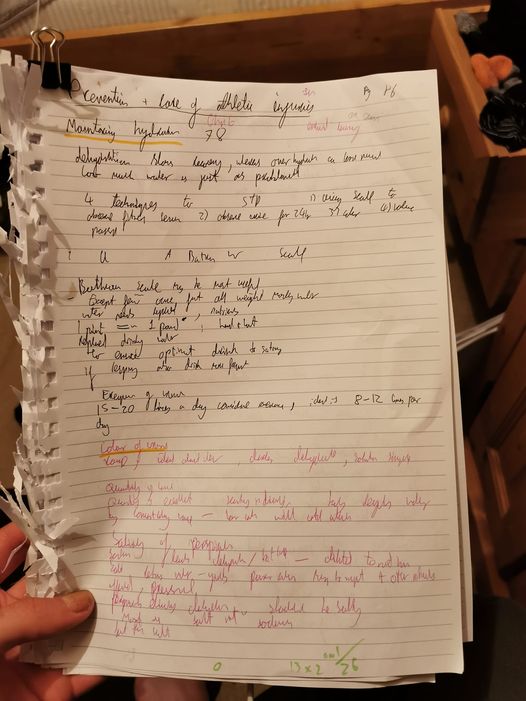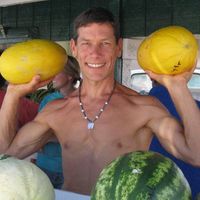Activity
Mon
Wed
Fri
Sun
Nov
Dec
Jan
Feb
Mar
Apr
May
Jun
Jul
Aug
Sep
Oct
What is this?
Less
More
Memberships
The 80/10/10 Community
229 members • Free
Love Fruit Community
715 members • Free
19 contributions to The 80/10/10 Community
Got Dexafit Scans and Testing Done
I got a Dexafit Body Scan, V02Max, and RMR Resting Metabolic Rate done. I was surprised to be 26% body fat my Bio impedance scale said I was 11.5%. I'm very under muscled and I do weightlift I'll share what weightlifting I do and my dexafit scan and test. I run 6 days a week too 4 to 6 miles each day so for me about 40 to 60 minutes per day so all steady state which is not good for muscles but will help me lose muscle so i have to do some HIT in there too. Any comments or help would be greatly appreciated. This post allows me to send up to 10 images so I'll try to attach the other 3 pages later if it will let me.

Which fruits do you enjoy in the autumn time?
I can’t wait for persimmon season, just the thought makes my mouth water😆 I live in the UK, so grapes and bananas are always a staple year round. How about you, what are your go to fruits this time of year?
Book Review of prevention and care of athletic injuries
" 1 purpose of myself having the idea to go through this book was because developing a type of injury/pain in the right heal of my foot ,after using type barefoot shoes for first time trying them seriously for a period of three months writing this - where I was trying running a certain distance using these type of cheap shoes every day - where. could be explanation why I developed an injury - cos not giving myself necessary time or adaptation period to transition to barefoot shoes. Then a second reason for going through this book would be - holistically feel like I'm kind of person who just hasn't always ever best payed attention to my body or bones/joints, have a background where I have blood flow problems from having "Raynaud's syndrome" due to toxicity/toxaemia with mercury heavy metal poisoning (AKA autism - which got symptoms after V@ccine). Overall I thought the book was through , went in depth about certain topics such as warming up , other factors such a monitoring hydration, and factors such as sleep which have an impact in recovery/recuperation. there were certain chapters which were less prevalent to myself such as protective gear, or gear for sports - because personally im not the kind of person who takes part in social sports groups due to being limited. warming up and cool down - chapter giving recommendations how to warm up prepare for any time exercise - made me think that I actually have a habit not spending much time warming up for strength training I do after seeing types persons say you don't need to. Over use, overload and overtraining" - was a chapter which caught my eye, because it was writing about scheduling for workouts - and is something which I feel like personally don't do perfectly, will have certain symptoms of soreness . chapters "enhanced recovery " talking about types of other environmental/lifestyle factors which have effect and "nutrition's role" - talking how a natural diet is the best recovery tool, Then the nine chapters after this - are Doug writing about how to approach recovery from being inured to fully healed.

Introduce Yourself! (Start Here - Please Read)
Welcome to The 80/10/10 Community. You are now entering a hidden oasis on the internet for aspiring coaches who want to develop their career as a certified 80/10/10 coach. Here's EXACTLY what to do first: Step 1: Introduce yourself BELOW using this Copy/Paste Template: What's your nickname? Where you from? Biggest strength? Biggest weakness? Which content platform is your favorite? What do you want immediate help with inside of this community? Step 2: Learn how to unlock everything by reading this. ------- Best practices in this community: • Try to level up quickly by commenting and posting your insights in the community. • Hit 'Like' 👍 on every helpful post or comment you see to help others level up. • When you write a post, break up your paragraphs into single sentences like I am doing now - this way more people will read what you write, and actually reply. • Make sure your profile picture is a photo of you. • Be cool. • If you ever get stuck, feel overwhelmed, are not sure what 'next step' to take, just ask the community. ------ Group Rules: 1) No Self Promotion 2) No Selling in the DM's 3) No Spamming the Community Feed
Poll
49 members have voted
humans vs monkeys
Hi, I would love to get Doug's or anyone else's in put on this. I found an article about human vs monkey anatomy and diet comparisons, and I read it very carefully. It is here: https://pubmed.ncbi.nlm.nih.gov/10378206/. First I want to say I very much prefer 801010rv to a cooked diet. But a couple of things in this article made me question it: 1) our digestive tracts aren't the same as monkeys. Human small intestines are twice as big as most monkeys and our large intenstines are half as long. The author said the monkey's large intestines absorb nutrients from the greens that they eat. My understanding is that the small intestines absorb digested food. There are some scientists who say we've been eating cooked food for 800,000 years which is long enough for us to evolve a digestive system suited for that--longer small intestines for absorption of cooked food? and shorter long intestines since we can cook our vegetables and don't need to digest them raw? and 2) the fruit monkeys eat is very different from cultivated fruits we eat today. Our fruits have much less fiber and more fructose and less glucose. However, if you take into account that sucrose is half glucose and half fructose, the amount of fructose vs glucose (when including sucrose contributions) is not terribly different. For monkey fruits, glucose is 60-50% and for our fruits, glucose is 50-40%, typically. but monkey fruits do have quite a bit more fiber it seems and aren't as sweet in general. So that suggests our fruit is not the same as our ancestors ate. However, neither are our cooked veggies and starches. I just began to wonder if our cultivated fruits are too low in fiber and too high in sugar to be optimal. and...if we should be eating some cooked veggies, which allows a larger variety and gives you more nutrients even though some are destroyed in cooking--but the articles I've seen say that you get 50% of your vitamins and all your minerals from cooked food (when you eat the broth as well).
1-10 of 19
@richard-gambino-8584
I’m a 17 year 80/10/10 raw vegan. I’m a farmer, craftsman and athlete. I love watermelon 🍉, bananas 🍌, durian, mangoes 🥭, peaches 🍑,persimmons ,
Active 334d ago
Joined Nov 15, 2023
Powered by





